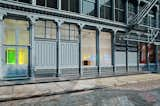Search “아이폰다이아거래ⅷdan-gol,cOm 아이폰빠른입금 아이폰소액업체✲아이폰최고가매입❉아이폰매입 아이폰현금화”
In the 1960s, artist Donald Judd—best known for the minimalist sculptures he referred to as "specific objects"—was one of the pioneers in transforming SoHo from overlooked industrial area to the center of the art world. Before his death in 1994, he planned for his home and studio, a five-story cast-iron building at 101 Spring Street, to be a permanent installation featuring more than 1,000 works of art, furniture pieces, and decorative and ceremonial objects. After a detailed restoration, 101 Spring opened to the public in 2013.
Image © Judd Foundation; Photo credit: Maris Hutchinson, EPW Studio; Judd Foundation Archive; Flavin artwork © 2015 Stephen Flavin/Artists Rights Society (ARS), New York; courtesy David Zwirner, New York/London; Licensed by VAGA
